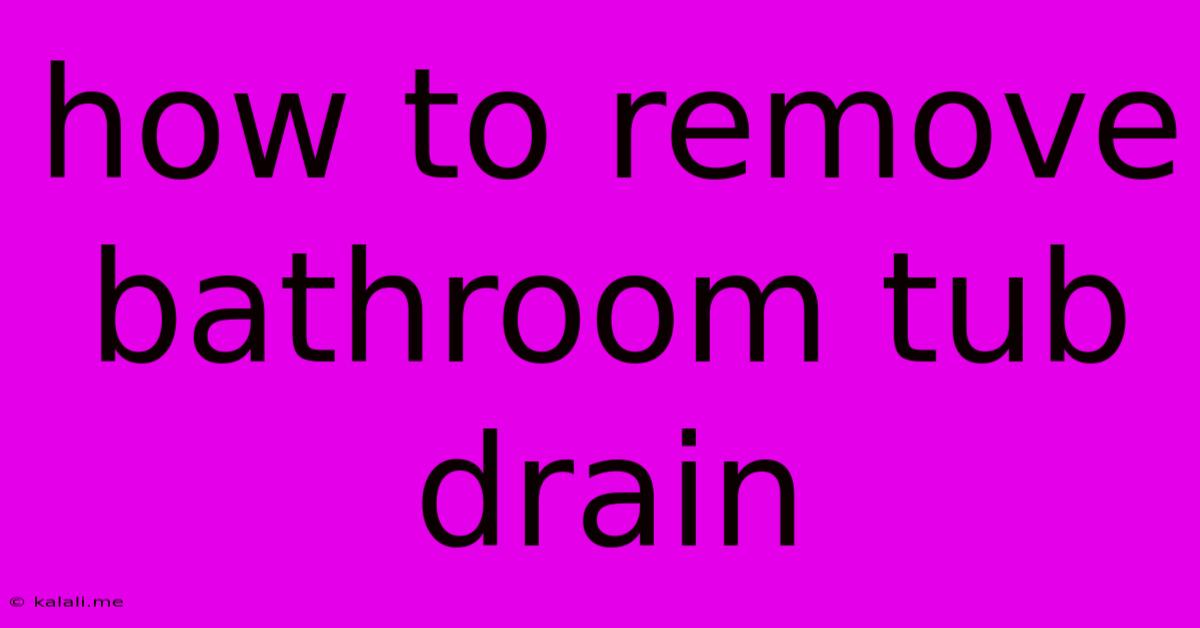How To Remove Bathroom Tub Drain
Kalali
May 29, 2025 · 3 min read

Table of Contents
How to Remove a Bathroom Tub Drain: A Step-by-Step Guide
Removing a bathroom tub drain might seem daunting, but with the right tools and a methodical approach, it's a manageable DIY project. This guide provides a comprehensive walkthrough, covering different drain types and potential challenges. This process will help improve your bathroom's drainage and overall cleanliness. Remember to always prioritize safety and turn off the water supply before beginning any plumbing work.
What you'll need:
- Screwdrivers: Phillips head and flathead, various sizes.
- Adjustable wrench: For tightening and loosening nuts.
- Pliers: Channel-lock or slip-joint pliers may be necessary.
- Bucket: To catch any remaining water.
- Old towels or rags: To absorb spills.
- Flashlight: For better visibility inside the drain assembly.
- Optional: Plumber's putty: For resealing the drain after reinstalling.
Types of Tub Drains:
Before starting, identify your tub drain type. Common types include:
- Slip-joint drain: This type uses a slip-nut to connect the drainpipe to the overflow pipe. It's generally the easiest to remove.
- Slip-on flange drain: A rubber gasket provides the seal, making it easier to remove and reinstall.
- Compression drain: Secured by a compression nut, this type might require more force and care.
Step-by-Step Removal Process:
-
Prepare the area: Remove any items around the tub to prevent damage or accidental breakage. Place a bucket underneath the drain to catch any residual water.
-
Remove the overflow plate: This is usually a small, round plate located near the faucet. Unscrew the plate with a screwdriver. You'll likely find a small nut securing the overflow pipe beneath; carefully loosen it.
-
Access the drain flange: Once the overflow plate is removed, you should have access to the drain flange.
-
Loosen the drain assembly: Depending on your drain type, you'll need to loosen either the slip nut (slip-joint), compression nut (compression drain), or remove the retaining clips (slip-on flange drain). Use appropriate tools and proceed carefully to avoid damaging the drainpipe or tub.
-
Remove the drain: Once the drain is disconnected, carefully lift it out of the drain opening. Be mindful of the plumbing connections and avoid any unnecessary force.
-
Clean the drain: While the drain is removed, take the opportunity to thoroughly clean the drain opening and any pipes that you can access. This can help resolve slow drainage issues.
Troubleshooting:
- Stuck drain: If the drain is stubbornly stuck, try using penetrating oil to loosen the connections. Let it sit for a few minutes before attempting to remove it again.
- Broken parts: If you encounter broken parts during the removal process, it may be necessary to replace the entire drain assembly.
- Difficult access: In some tubs, access to the drain assembly might be difficult. Using a flashlight and working carefully will be essential.
Reinstallation (Reverse the process):
After cleaning, reassemble the drain in the reverse order of removal. If using plumber's putty, apply a thin layer around the drain flange before installing to ensure a proper seal.
When to Call a Plumber:
If you encounter significant difficulties, aren't comfortable working with plumbing, or damage the drain assembly during removal, it’s best to contact a qualified plumber.
By carefully following these steps, you can successfully remove your bathroom tub drain. Remember to prioritize safety and take your time to avoid damage. With a little patience, you'll have a cleaner, better-functioning tub in no time!
Latest Posts
Latest Posts
-
When Do You Get Your Reaction Back 5e
May 31, 2025
-
What Is The Red Wire In A Light Switch
May 31, 2025
-
How To Solve Log Equations Without A Calculator
May 31, 2025
-
How To Tell If A Bike Rim Is Tubeless
May 31, 2025
-
How Do You Wire A Transformer
May 31, 2025
Related Post
Thank you for visiting our website which covers about How To Remove Bathroom Tub Drain . We hope the information provided has been useful to you. Feel free to contact us if you have any questions or need further assistance. See you next time and don't miss to bookmark.